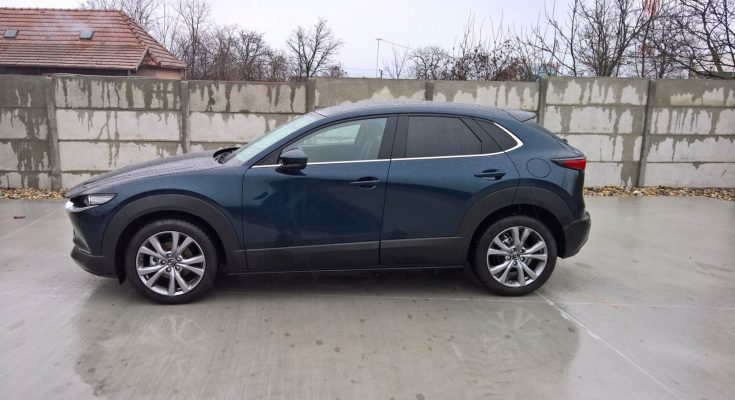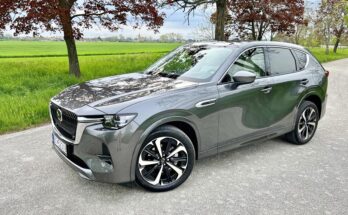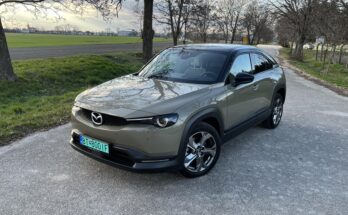The great Mazda3 has already shown itself as a classic sedan and an interesting hatchback . But now comes the stylish crossover/SUV CX-30, which is a practical replacement for a station wagon.
At first glance, it might seem that Mazda has been in the clear for a long time in cars capable of going off-road. In the crowded segment of compact SUVs and crossovers, however, the Japanese also tested the Mazda CX-30, a car based on the fourth generation of the Mazda3 (the CX-3 is technically close to the Mazda2 and the CX-5 to the Mazda6).

Looking at the sporty silhouette with a very economical glass surface, few would guess that the new CX-30 is a direct competitor to the "home" Skoda Karoq. The CX30, however, is more likely aimed at customers who like the ride in the new three, but already have a family that they can't fit into it even with their best will.

And here, the CX-30, which is a few centimeters higher, makes sense, because it was able to build a place where two adults can comfortably sit, and three smaller children with squinted eyes, from the modest space conditions on the rear seats of the hatchback. Access to the rear seats is a bit worse, thanks to the cutouts for the fenders, and the legroom is increased by the cutouts in the front seats, but it can be considered a solution appropriate for the platform. The variability of the interior is average and there is no great glory here. By folding down the rear backrests, a single plane is created with the trunk, but the cargo edge is ten centimeters higher than its bottom. The backrests are divided in a ratio of 1:2, but you would search in vain to adjust their inclination or even to move the seat by a few centimeters – just like the ski tunnel.

As for the interior, for example, the instrument panel is virtually unchanged from the Mazda3. Driver oriented, with great design elements and curves. That's what makes Mazda a bit different from mainstream production. An example should also be infotainment, which, despite all trends, still rejects a touch screen. It is operated using a classic rotary controller supplemented by several buttons on the center console, and you will be amazed – you can handle the whole operation almost like a fool after a little practice. Not to mention that the mechanical buttons connected to the display must also cost more in terms of production costs than the ordinary touch screen that China is splurging on…
The pleasant operation of the infotainment system with the central controller deserves praise, as does the significantly shorter response time of the entire system than I was used to with Mazda. The system is about twice as fast as in the last tested Mazda6. Both Apple CarPlay and Android Auto are included as a matter of course, and video playback from a USB flash drive is a novelty (the function is, of course, blocked when the car is in motion). And one more thing – the Bose car radio with twelve speakers is really worth paying extra for. The CX-30's exceptionally well-damped interior makes its excellent balanced sound stand out.

The interaction between the driver and the vehicle works just as well in the CX-30. Controlling the car is so smooth and natural, as if driving a vehicle with a manual transmission is not an activity that requires physical effort at all. To a large extent, this feeling is due to the amazingly precise and short paths of the shift lever and undoubtedly also the ingenious ergonomics of the driver's workplace. Once again, I would like to highlight something that Mazda has worked on really radically in its new models. It is the soundproofing of the interior, which is designed with such thoroughness in the CX-30 that the crew knows very little about the engine, the chassis, but also about the noise of the surrounding air behind the windows. The only complaint was the rattling driver's window winder on the tested model, which is certainly not a common problem. Otherwise, the seating, driving and atmosphere are almost like those of premium brands.

In the case of the CX-30, Mazda made do with classic shock absorbers and a structurally simpler trailing rear axle for this tuning. The higher center of gravity of the vehicle, compared to the Model 3, required the use of larger stabilizers and stiffer springs in order to keep the tilting of the body under control, so the quality of the road decides the slight discomfort. The CX-30 is tuned harder, following the example of the Mazda3 , but shocks from the rear axle have largely been eliminated. However, problems with stability are an unknown concept, as with its smaller sister, and it takes a very large dose of own stupidity from the driver for the CX-30 to refuse to follow the trail in the desired direction. Undercarriage per unit with an asterisk.
Mazda paid a lot of attention to matching the steering with precise shifting in the CX-30, the vehicle is controlled naturally and fun. The outstanding characteristics of the chassis are aided by electronics, for example, the new function of torque control ensures a faster return to the front wheel in a straight direction after passing a corner with the help of light braking of the outer wheels.

The two-liter four-cylinder Skyactiv-G produces, on paper not very impressive, 90 kW (122 hp) and is unique in itself. Mazda has given it a high compression ratio (13:1), while at the same time it prescribes a completely normal gasoline with an octane number of 95. This technical "miracle" is enriched anew by shutting down two cylinders at low load, which, in combination with the mild-hybrid system, saves fuel . When driving on two cylinders, you can feel the vibrations that are transmitted to the steering wheel. But it's nothing to live with. I also understand that this system cannot be turned off – because of emission standards, but it is sometimes slightly annoying.

The atmospheric two-liter is best suited to calm drivers, and its character with a linear onset of performance is wonderfully addictive. The reward for the lack of a turbo is a stable low consumption without significant fluctuations depending on the driving style. Dynamic driving is of course possible when you exceed the 3,500 rpm limit, but the feeling of pull that is conveyed by much smaller turbo engines is missing here. I was regularly getting 6.5L/100km, which is great value for the size of the car and the power.

In terms of price, the CX-30 is ranked somewhere in the middle of the competition. It has everything you need already in the basic equipment: LED headlights, air conditioning, color infotainment display including navigation, car radio with eight speakers including DAB reception, a small leather package, etc. You can buy four packets to the base or have them all at once in one. The price then includes, for example, perfectly functioning adaptive headlights, the aforementioned Bose car radio with twelve speakers, two-zone air conditioning, a panoramic camera, a leather interior (optionally also in white) and much more.
The new CX-30 offers exactly what fans of this brand expect from it: great driving characteristics, good equipment and also a certain amount of practicality. The fact that it is not one of the most spacious in its class will amply compensate you with driving experiences and connection with the road…
| Technical specifications | Mazda CX-30 2.0 Skyactiv-G 122 |
| Engine type: | Spark plug |
| Cylinders / valves: | 4 / 16 |
| Displacement (ccm): | 1998 |
| Highest power (kW(k) / rpm) | 90 (122) / 6000 |
| The highest twist. torque (Nm / rpm): | 213 / 4000 |
| Gearbox: | 6-st. manual |
| Acceleration 0 – 100 km/h (s): | 10.6 |
| Combined consumption – WLTP (l/100 km): | 5.1-6.8 |
[rl_gallery id=”8005″]




